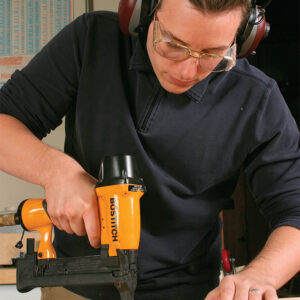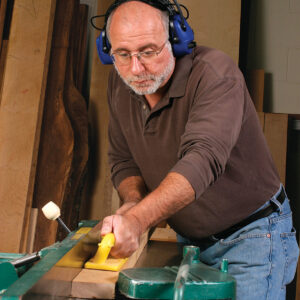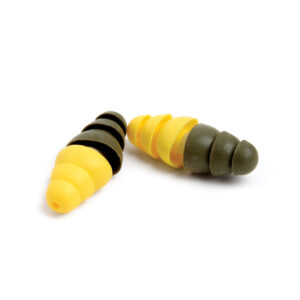Sound Advice for the Woodshop
Smart earplugs and muffs leave you no excuse for unprotected ears.
Synopsis: Hearing protectors are as essential to a safe, well-equipped shop as good lighting, safety glasses, and a dust collector. After all, the noise made by shop machines will damage your hearing. Yet in a recent poll on this Web site, 1 in 10 woodworkers said they usually don’t wear hearing protection. There are hundreds of varieties of hearing protectors on the market, ranging from disposable foam plugs that cost about a dollar a pair up to electronics-laden earmuffs that sell for close to $200. What’s best? Fine Woodworking editors conducted an informal test of a variety of types, and generally preferred muffs to plugs. But experts say the most effective hearing protectors are the ones that are comfortable and easy to use–the ones you’ll actually wear.
Short bang, long drone: both BAD
Pneumatic nailers emit what’s known as impulse noises. They last only a fraction of a second, too short for our brains to register the sound as loud. In fact, a nailer can be louder than other shop machines, such as a jointer or a tablesaw.
 |
 |
Hearing protectors are the workshop equivalent of the galoshes your mother nagged you to wear.
If you obeyed your mother then, chances are you’re pretty diligent now about using hearing protectors whenever you turn on noisy shop machines. But if you didn’t listen to Mom, you probably forgo ear protectors, thinking they’re too uncomfortable, you’ll get used to the noise, or you needn’t bother because you’ll be working for only a few minutes. And you probably still wreck your dress shoes in the rain.
We recently posted a poll on FineWoodworking.com asking what type of hearing protection people used most often. More than 6 in 10 of the 1,018 respondents said they used earmuff-style protectors. Disposable foam plugs came in a distant second. But 1 in 10 said they usually don’t wear hearing protection.
In fact, hearing protectors are as essential to a well-equipped, safe shop as good lighting, safety glasses, and an effective
dust collector. Sounds that are too loud will damage your hearing, even if they only last a short time. The louder the sound, the faster it can cause harm. And you don’t get used to loudness—you lose your hearing and/or end up with tinnitus, a permanent ringing in the ears. The problem is that hearing damage builds up in tiny increments over the course of a lifetime, and before you know it, it’s too late.
You probably need to wear hearing protectors more often than you think, but that no longer has to mean using plugs that seem as form-fitting as a tapered 2×4 or wearing muffs that make you feel as if you’re in a soundproof room.
Noise levels, tool by tool
Sound is measured in decibels, a unit named for Alexander Graham Bell, who was known for his research into acoustics and deafness before he invented the telephone. The decibel scale is logarithmic, not linear. Every 3-db. increase means a doubling of the sound energy hitting the ear.
We can safely tolerate sounds up to about 85 db. But as the graph at right shows, many shop machines emit much more sound. Past that 85-db. threshold, you must limit exposure and don hearing protectors to avoid long-term damage.
The National Institute for Occupational Safety and Health maintains an online database that lists the loudness of 120 popular tools from 14 manufacturers (www.cdc.gov/niosh/topics/noise/workplacesolutions/toolsDatabase.html). You also can play a 5-second-long audio file for each tool.
A wave of new technology
The simplest, least expensive earplugs and muffs reduce sound levels uniformly. They’re designed to absorb some of the energy in the sound waves hitting our ears, cutting it by, say, 20 db. Many newer products are smarter, providing variable protection. Some plugs have pinholes that allow you to hear sounds at safe levels but reduce louder, harmful noises.
Others have various kinds of acoustic baffles. Many promise improved comfort. Newer earmuff-style protectors come with electronics to help minimize the plugged-up and isolated feeling you can get from conventional muffs. Some have a microphone that picks up nearby sounds. Others have an FM/AM radio. Still others combine the microphone and the radio. What all these smart muffs have in common is the ability to cap the noise level hitting your ears at 80 to 82 db.
Noise-canceling headphones may be the most sophisticated type of hearing protector, but they may not be the best for woodworkers. Sold mainly to travelers seeking relief from the drone of jet engines, these headphones generate an inverted version of the sound wave coming toward your ear, which effectively cancels the sound. Some researchers said that noise-canceling headphones work best with steady, constant sounds but are less effective with the relatively short bursts from shop machines.
All plugs and muffs can do the job…
Any hearing protector on the market will cut sound by 10 db. or more. Some claim to reduce sound by 25 db. or more. They’re more than adequate for muffling the noise from machines in a home woodshop. In fact, it’s pointless to try to figure out which specific hearing protector might actually offer a higher level of protection. Turns out, there’s no way to know for sure.
Most hearing protectors carry a Noise Reduction Rating, or NRR. The number, derived from lab tests under ideal conditions, is supposed to indicate how many decibels of protection the product provides. But the lab tests don’t track with real-world conditions. Each manufacturer does its own testing under somewhat different conditions, so the NRR can’t be used to compare brands. It wasn’t surprising that one government audiologist I spoke with joked that NRR actually means “not really relevant.”
… so comfort and convenience are key
Hearing protectors range from disposable foam plugs that cost about a dollar a pair to electronics-laden earmuffs that sell for close to $200. What’s best? Every expert I spoke with offered the same piece of advice: The best hearing protectors are the ones you’ll wear regularly. That means you want something comfortable and easy to use.
To gauge the comfort and convenience of some new protectors, I asked several Fine Woodworking and Fine Homebuilding editors to make informal comparisons. Each person tried four hearing protectors—two earmuffs with built-in radios, microphones, or both, and two sets of earplugs. I chose the products based on advice from experts and my own research.
People compared two products at a time, using noisy shop machines for 10-minute stretches. They had to decide whether they preferred one product, based on factors including ease of use, comfort, and whether the wearer still could hear normal sounds. I also asked if they would use the product regularly.
The panelists’ favorites
Overall, people preferred earmuffs to plugs. It’s simply easier to pop a set of muffs over your ears than to insert plugs every few minutes.
Most of the negative comments about earplugs concerned difficulty with fitting them into the ear. These plugs are only slightly easier to fit than older foam plugs. Yet nearly everyone said they liked a favorite plug or muff well enough to use it regularly.
Peltor Worktunes, a muff with a built-in radio, was the overall favorite. Comfortable, with an easy-to-use radio and a moderate price tag, it would make a good first choice. If the radio becomes a distraction, you can always turn it off.
Three other muffs were a close second: The Bilsom Radio (similar to the Peltor but costlier), the Bilsom Electo (pricey muffs with both microphone and radio), and microphone-enhanced muffs from Lee Valley Tools. The Elvex QuieTunes were least preferred; several people complained that the radio picked up static from shop machines.
Among earplugs, people said the AOSafety and Noise Brakers allowed them to hear normal conversation. The AOSafety is a double-ended plug: One end delivers a constant level of protection; the other muffles impulsive sounds. Those would be good for anyone who uses a pneumatic nailer. At least one person favored the QuietEar and BlastBusters plugs; others called them hard to put on. One tester preferred the unique Zem by Sensgard, designed to direct sounds away from the ear.
Earplugs
Simple and inexpensive, plugs can provide ample hearing protection. The ones shown here typify new designs that let normal sounds through but block harmful ones. The plug’s biggest drawback is difficulty of use. Most are tricky to insert in the ear properly.
 |
AOSafety Range E.A.R. Plugs $13
What it does: Provides two kinds of protection. Yellow end gives variable protection for impulse noises. Olive end gives constant noise reduction. Panelists’ comments: Lets voices through. Source: www.aosafety.com |
 |
BlastBusters Shooter’s Ear Plugs $18
What it does: Reduces ambient noise levels by about 75%, but limits impact noise to 80-85 db. Panelists’ comments: Easy to use if wearing eye protection. Source: www.earplugstore.com |
 |
Hocks Noise Brakers $20
What it does: Reduces all sound approximately to the volume of normal speech. Designed so that escaping sound waves cancel dangerous noises. Panelists’ comments: Lets voices through. Source: www.hocksproducts.com |
 |
QuietEar $6
What it does: Reduces sound volume by half, with additional protection above 85 db. Panelists’ comments: Couldn’t get them to fit. Source: www.heartech.co.il |
 |
Zem by Sensgard $20
What it does: Uses specially designed headband to direct sounds away from ears; filters out the most damaging frequencies. Panelists’ comments: Picked up too much ambient noise (“I could hear myself chewing my own gum.”) Hard to adjust. Source: www.zemzone.com |
Muffs
Sophisticated new muffs, like those shown here, don’t just cover your ears to block noise. Some contain electronics that let you hear some normal sounds but keep the noise at a safe level. Some offer built-in radios for entertainment and to reduce the sense of isolation.
 |
Bilsom Electo $185
What it does: Uses microphone to pick up ambient noise, and has built-in FM/AM radio. Sounds from mic or radio limited to 82 db. Panelists’ comments: Lightweight. Source: www.hearingportal.com |
 |
Bilsom Radio $85
What it does: Has built-in FM/AM radio. Radio’s loudness limited to 82 db. Panelists’ comments: Good radio, but muffs not as comfortable as some others. Source: www.hearingportal.com |
 |
Elvex QuieTunes COM-660 $70
What it does: Has built-in FM/AM radio. Radio’s loudness limited to 82-85 db. Panelists’ comments: Radio picked up static from shop machines. Source: www.elvex.com |
 |
Lee Valley electronic hearing protectors $30
What it does: Uses microphone to pick up ambient noise. Sounds from mic limited to 85 db. Panelists’ comments: Liked ambient noise through microphone. Easy to use with eyeglasses. Source: www.leevalley.com |
 |
Peltor Worktunes-22 $49
What it does: Has built-in FM/AM radio. Radio limited to 82 db. Panelists’ comments: Fit better than others over safety glasses. Controls easy to use. Source: www.peltor.com |
David Heim is an associate editor.
From Fine Woodworking #189
For the full article, download the PDF below:
Fine Woodworking Recommended Products

Jorgensen 6 inch Bar Clamp Set, 4 Pack

Dustopper Pro

Rockler Dust Right 1250 CFM
























Log in or create an account to post a comment.
Sign up Log in